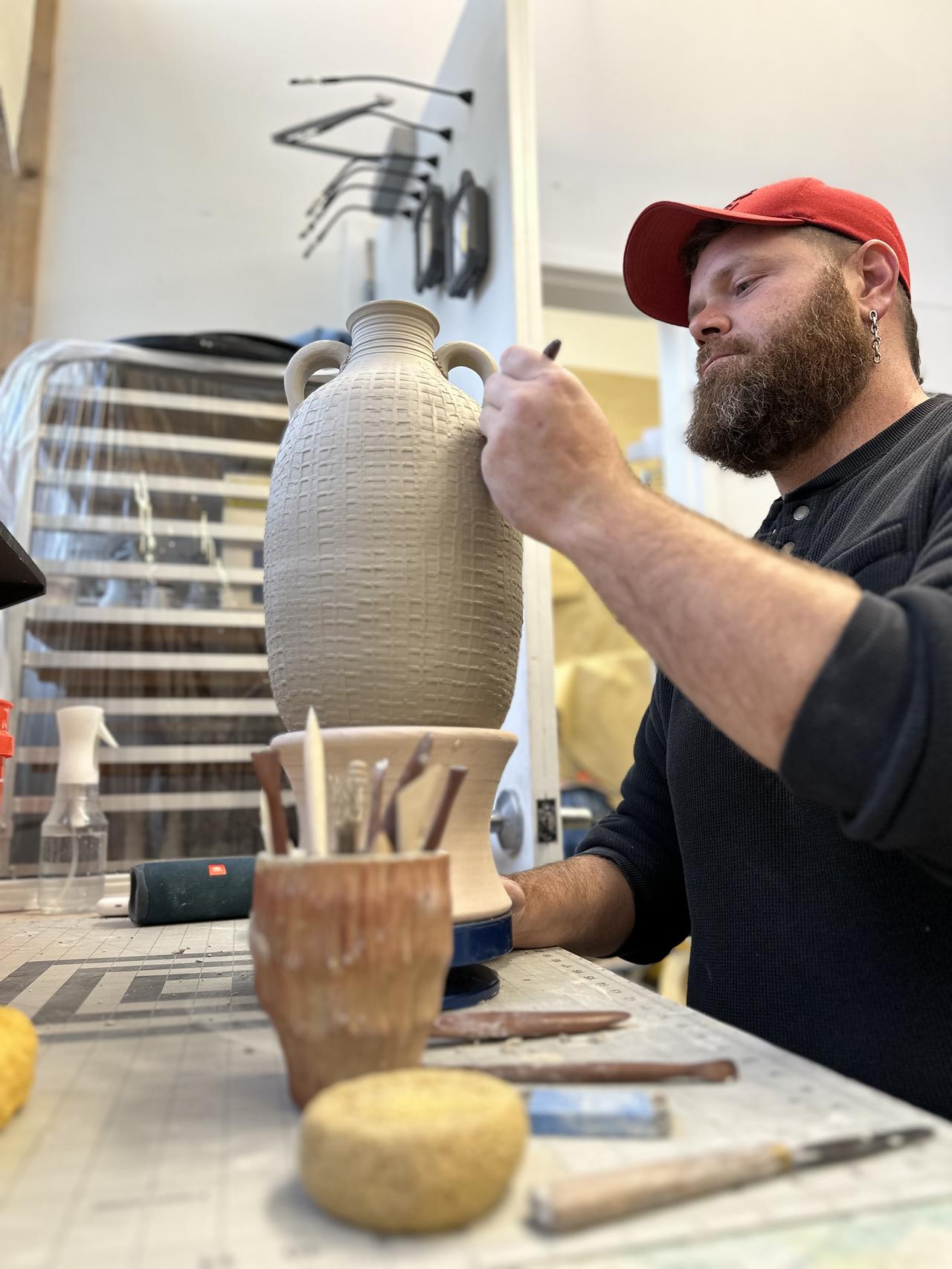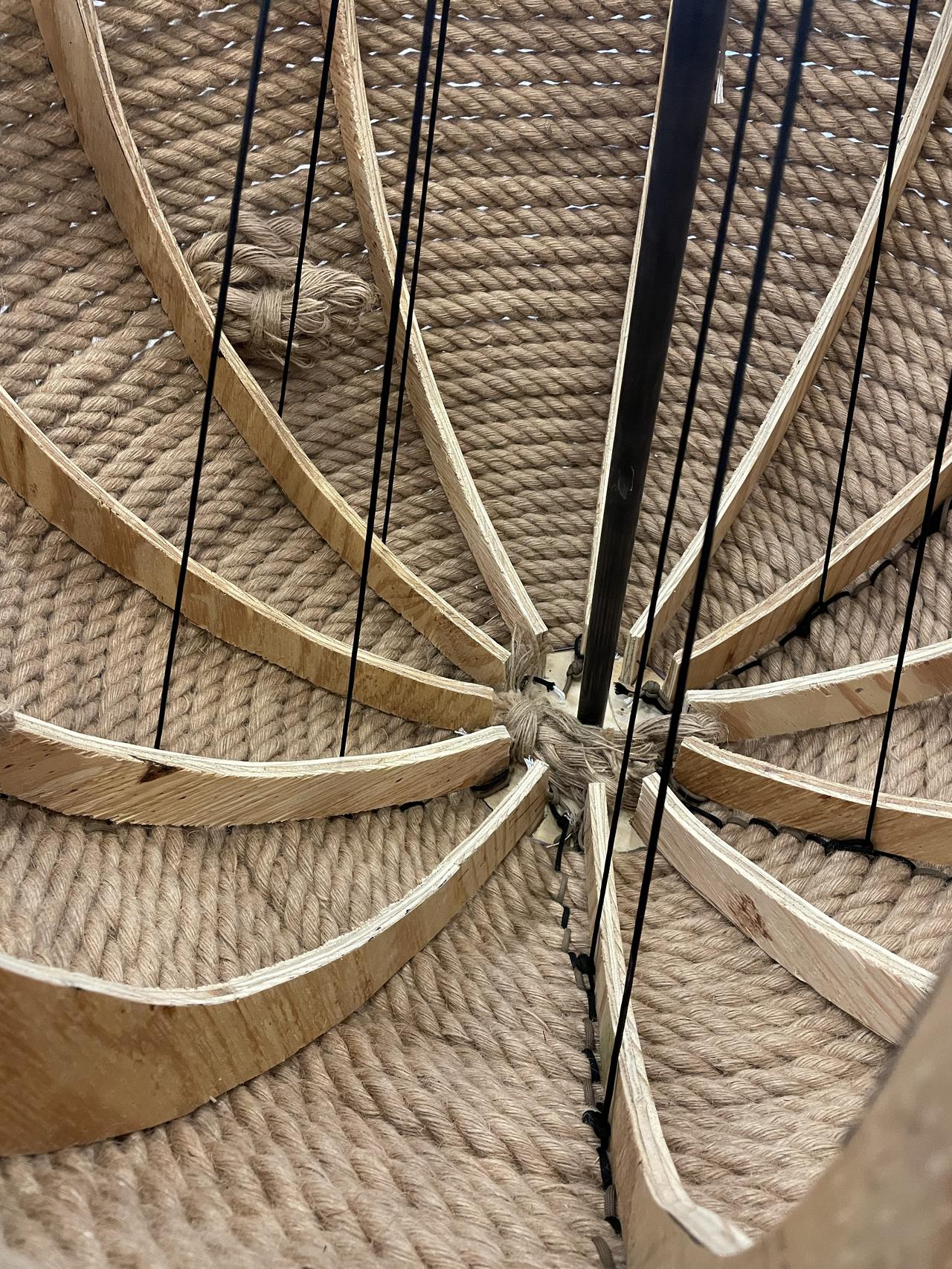about
-

Bio
Bradford Davis is a multimedia artist who uses ceramics as the physical matrix to express feelings, emotions, and responses to his life experiences. As a disabled veteran, Davis mines his traumas and journey of healing to feed his creative research.
He mixes various materials with the ceramic vessel to express and highlight the personification of the vessel in its destruction, restoration, and rebirth. In functional work, Davis explores layered surface through imagery and additive/subtractive methods to build a palimpsest of color, texture, and memory.
Davis earned his MFA at Temple University’s Tyler School of Art & Architecture and his BFA from the University of South Carolina, both with a focus in ceramics. He has been an artist in residence at Tainan National University of the Arts, Taiwan. His works have been shown internationally and can be found in the collection of the McKissick Museum.
He teaches hand-building and throwing advanced ceramics classes at local community arts centers, and is building a program to teach ceramic workshops to veterans alongside recreational therapists.
As a veteran, Davis explains that the community of art and ceramics - the people and purpose of clay, helped his journey of healing more than any prior therapy. During his long term residency at The Clay Studio, his main focus is building and developing a supportive veteran focused ceramics program and network so he can share his legitimate life changing experience with others.
Studio View, 2024
-

Artist Statement
Dear Viewer,
I am humbled to say that the return to clay, and more importantly – the community of clay, has been one of the greatest catalysts in my path of healing. As a veteran contemplating the sum of my life experiences and their weight on my mental health, I have come to co-exist with my traumas and disabilities, journeying through various stages of denial, acknowledgment, bargaining, disassociation, and acceptance.
My artistic practice is fueled by the repetitive deconstruction and reconstruction of the archive of trauma that I have walked with for over a decade. This mirrors aspects of a common therapy practice known as cognitive behavioral therapy, the second go-to treatment plan of the Department of Veterans Affairs, Mental Health Clinics — second only to intense medication regimens. As a patient, I stagnated for over a decade from failed interactions, treatment plans, and a deluge of ever-changing medications and their side effects: years of isolation, fear, instability, insanity, reflection, and breaking bread with demons I never knew existed. During this period, I was incapable of engaging with clay, convinced that I would discover yet another passion I was no longer able to enjoy due to my injuries.
In my practice, I seek clarity, questioning boundaries and my own limitations through the process of engaging clay. Perhaps for many, the malleability of clay leads to a greater awareness of self, a conversation between the material and the maker. The unpredictability of the ceramic process that I explore through stress, fracturing, and deformation strikes a chord in my brain — a vibration of internal calmness providing a brief respite from my mind’s exhaustive mental war games.
In my research, I have come to appreciate a simple historical vessel known as the amphora. Rich in history, this vessel was originally designed as a durable container to ship goods long distances. Within this durability and the personification of the vessel, I find my expressions. Having spent much of my life under the required expectation of being unbreakable, I find a sympathetic thread within these amphorae. Exploring this form in its creation, deformation, and restoration; I challenge those prior expectations of perfection, and re-contextualize what it means for me to be whole.
Detail, Sphere Rope, 2024
-

CV
SUMMARY OF QUALIFICATIONS
- Developed and implemented multimillion-dollar construction, training, management, tactical, and civic arts/cultural projects throughout the U.S. and abroad.
- Resident Artist – The Clay Studio
- Visiting Artist in Residence - Tainan National University of the Arts.
- MFA - Tyler School of the Art and Architecture, Temple University.
- Best in Show, 30th Annual “Strictly Functional” International Ceramics Exhibition.
- Recognized, decorated, and honored personally by the 37th Chairmen - Joint Chiefs of Staff, for exemplary service, dedication to duty, and combat effectiveness.
WORK SUMMARY
- Review Panelist, Mid Atlantic Arts for NJ State Council of the Arts, Remote, 2024
- Teaching Artist, The Clay Studio; Philadelphia, PA 2024
- Wood Kiln Supervisor, Historic Yellow Springs Studio; Chester Springs, PA, 2022
- Conference Assistant, World Stoke 2022; Sacramento NCECA
- Artist Assistant: George Rodriguez 2022-2023
- United States Army, Field Artillery Officer Corps, 2008-2015
- Fired Stone Studios, (DBA), West Chester, PA 2008
- Visiting Artist in Residence, Tinian National University of the Arts, 2007
- Designed, marketed, produced and directed a solo exhibition silent auction raising $10,000 in support of 3 charities within the greater Columbia, SC area.
- Artist Assistant: Virginia Scotchie 2005-2008;2022
- Assisted in creation, shipping & handling, and installation of “Floating Spheres of Continuity”, permanent instillation, Yinggie Ceramics Museum, Yinggie, Taiwan.
- Gallery Assistant: McMaster Gallery 2006
- Restoration Construction: Summers 2005-2008
- Worked under Gene Butcher - Master Carpenter and Jerry Bessenger - Master Metalsmith. Restored historic buildings in style and manner of original construction.
- President, Carolina Clay Artists Association, University of South Carolina, generating grants and support for CCAA in excess of $25,000.
SELECTED EXHIBITIONS
- 2024
- Solo MFA Thesis Exhibition “Failing Forward”, Temple Contemporary, Tyler School of Art & Architecture – Philadelphia, PA
- Co-Curated Exhibition “The Art of the Book”, Charles Library Temple University – Philadelphia, PA (1-10 collaborating curators)
- Exhibition “How long does it take for a Peacock to die?”, Atelier Art Gallery – Philadelphia, PA
- 2023
- Exhibition “Blurring the Lines”, Tyler School of Art & Architecture – Philadelphia, PA
- Exhibition “Small Favors”, The Clay Studio – Philadelphia, PA
- Exhibition “Dreamtopia”, Stella Elkins Gallery – Philadelphia, PA
- 2022
- Exhibition “Tyler MFA Ceramics”, Hunter Collage, CUNY – New York City, NY
- Exhibition “Strictly Functional”, Juried National, Lancaster Museum of Art – Lancaster, PA
- Exhibition “Temple of Joy”, Temple Contemporary Gallery - Philadelphia, PA
- Featured Artist “Brandywine Cottage Gardens” – Downingtown, PA
- 2008
- Exhibition “Time”, Sunset Hill Gallery - West Chester, PA
- Museum Exhibition “Art, from South Carolina to Taiwan”, Columbia City Museum of Art - Columbia, SC
- Museum Invitational “Afaa Weaver”, Columbia City Museum of Art - Columbia, SC
- Museum Invitational “Spring for Art”, McKissick Museum - Columbia, SC
- Exhibition “Object Based”, Carillon Gallery - Charlotte, NC
- 2007
- Exhibition “White on White”, Artist’s Basement - Columbia, SC
- Exhibition “This and That”, C Space Gallery - Kaohsiung, Taiwan
- Exhibition “USC Past and Present, 15 years Retrospective”, Franklin G. Burroughs Simeon B. Chapin Art Museum - Myrtle Beach, SC
- Undergraduate Thesis Exhibition “Contingent Existence”, McMaster Gallery - Columbia, SC
PUBLICATIONS
- The Art of the Book
- A Look at a Book Series, episode 15 – Giovanni Piranesi, ‘Le Antichita Romane 1756
- McKissick Museum Digital Collections
- “Taking Shape” a documentary of the creation and installation of ‘Floating Spheres of Continuity”, a large-scale public installation by Virginia Scotchie
EDUCATION
- MFA - Ceramics, Tyler School of Art and Architecture, Temple University, 2024
- Post Baccalaureate - Ceramics, Tyler School of Art and Architecture, Temple University, 2022
- Officers Candidate School, U.S. Army, Ft. Benning, GA, 2010
- BFA - Ceramics, University of South Carolina, Columbia, SC, 2007
AWARDS & HONORS
- Best in Show – 30th Annual “Strictly Functional” International Ceramics Exhibition, 2022
- Purchase Award – 30th Annual “Strictly Functional” International Ceramics Exhibition, 2022
- Nominated for the University of South Carolina Distinguished Alumni Award, 2022
- Bronze Star Medal, U.S. Army, R.C. South Afghanistan, 2012
- Purple Heart, U.S. Army, R.C. South Afghanistan, 2012
- Army Award for Maintenance Excellence for the 8th Army, U.S. Army, Camp Casey, S. Korea, 2011
SELECTED COLLECTIONS
- McGarvey Family Collection – Collector - Chester Springs, PA
- Kaohsiung Fine Arts Museum - Kaohsiung, Taiwan
- McKissick Museum - Columbia, SC
- Tseng Fangling - Collector - Kaohsiung, Taiwan
- Li Chun Lan - Collector - Tainan, Taiwan
EMPLOYMENT HIGHLIGHTS, PUBLIC WORKS & MILITARY
- Senior Training & Project Developer October 2013 – March 2015; U.S. Army, Fort Sill, OK
- Synchronized the needs and input of 2 separate schools and 8 departments to generate a user-friendly product capable of distance learning, study guide applications, and testing. This program was designed for a user base of 4,000 personnel annually.
- Fires Cell Department Head January 2012 - October 2013; U.S. Army, Joint Base Lewis McChord, WA
- Contracted & supervised the construction of over 9 kilometers of military grade tactical roads, 8 Host Nation security outposts, 5 bridge systems, 16 drilled wells, and the construction or refurbishment of 5 village schools and mosques within Regional Command South of Afghanistan: projects totaling over $10 million.
- Chief Executive Officer December 2010 - January 2012; U.S. Army, Camp Casey, Korea
- Developed a management and distribution plan adopted by an organization of 1800 personnel for use in the 8th Army level command inspection program.
- Received the 8th Army Award for Maintenance Excellence for designing the top-rated maintenance and records program out of all U.S. Army forces in South Korea.
Detail, Approach the Missing Pieces as Open Doors, Ceramic Stoneware, Wire, 2022